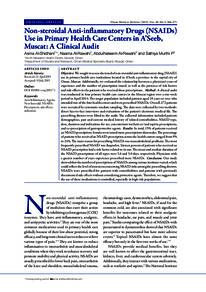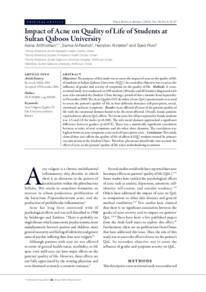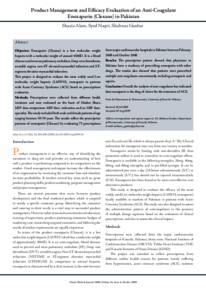Document
Non-steroidal anti-inflammatory drugs (NSAIDs) use in Primary Health Care Centers in A'Seeb, Muscat : a clinical audit.
Identifier
DOI 10.5001/omj.2015.73
Contributors
Publisher
Oman Medical Specialty Board.
Gregorian
2015-09
Language
English
Subject
English abstract
Objective: We sought to assess the trend of non-steroidal anti-inflammatory drug (NSAID)
use in primary health care institutions located in A'Seeb, a province in the capital city of
Oman, Muscat. Additionally, we evaluated the relationship between a physician's years of
experience and the number of prescription issued, as well as the presence of risk factors
and side effects in the patients who received these prescriptions. Method: A clinical audit
was conducted in four primary health care centers in the Muscat region over a one-week
period in April 2014. The target population included patients aged 18 years or over who
attended one of the four health centers and were prescribed NSAIDs. Overall, 272 patients
were recruited by systematic random sampling. The data were collected by two methods:
direct face-to-face interviews and evaluations of the patient's electronic medical file. The
prescribing doctors were blind to the audit. The collected information included patients
demographics, past and current medical history of related comorbidities, NSAID type,
dose, duration and indications for use, concomitant warfarin or/and aspirin prescriptions,
and co-prescription of gastroprotective agents. Results: In total, 15% of patients received
an NSAID prescription: females were issued more prescriptions than males. The percentage
of patients who received an NSAID prescription across the health centers ranged from 9%
to 24%. The main reason for prescribing NSAIDs was musculoskeletal problems. The most
frequently prescribed NSAID was ibuprofen. Sixteen percent of patients who received an
NSAID prescription had a risk factor related to its use. The mean and median duration of
the NSAID prescriptions of all types were 5.6 and 5.0 days, respectively. Physicians with
a greater number of years experience prescribed more NSAIDs. Conclusion: Our study
showed that the number of prescriptions of NSAIDs among various institutes varied, which
could reflect the level of awareness concerning NSAID risks among the prescribing doctors.
NSAIDs were prescribed for patients with comorbidities and patients with previously
documented side effects without considering protective agents. Therefore, we suggest that
the use of these medications is controlled, especially in high-risk populations.
Member of
Resource URL
Citation
Al-Shidhaniyah, Asma, Al-Rawahiyah, Naama, Al-Rawahi, Abdulhakeem, & Panchatcharam, Sathiya Murthi (2015). Non-steroidal anti-inflammatory drugs (NSAIDs) use in Primary Health Care Centers in A'Seeb, Muscat : a clinical audit. Oman Medical Journal, 30 (5)
Category
Journal articles




